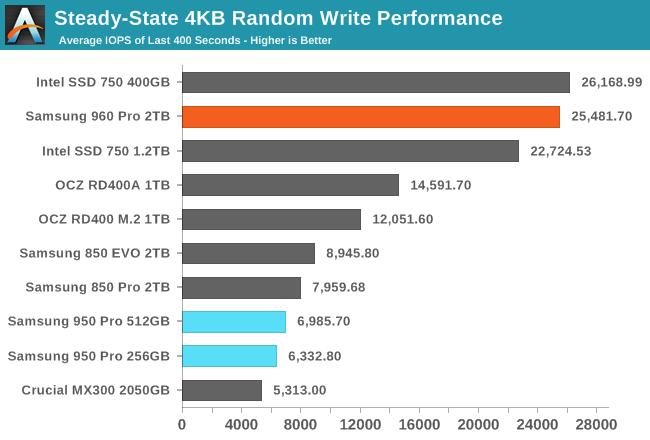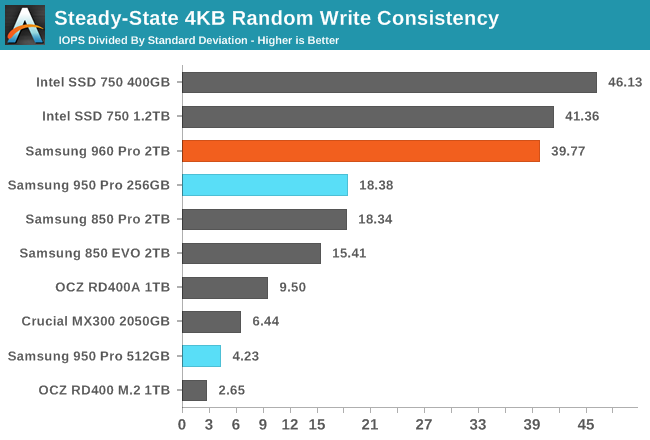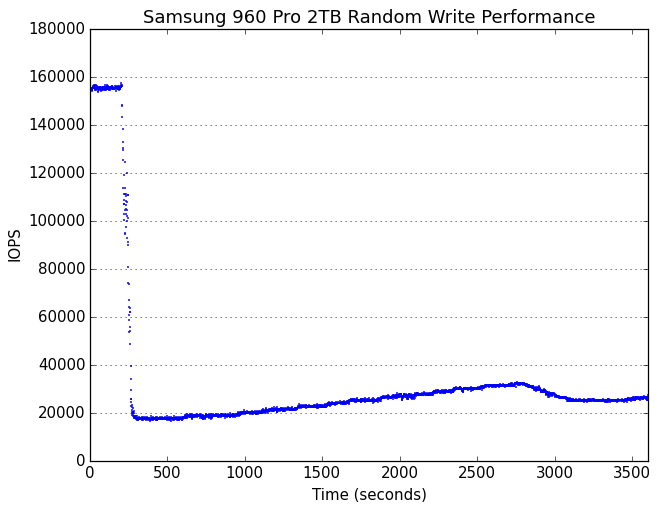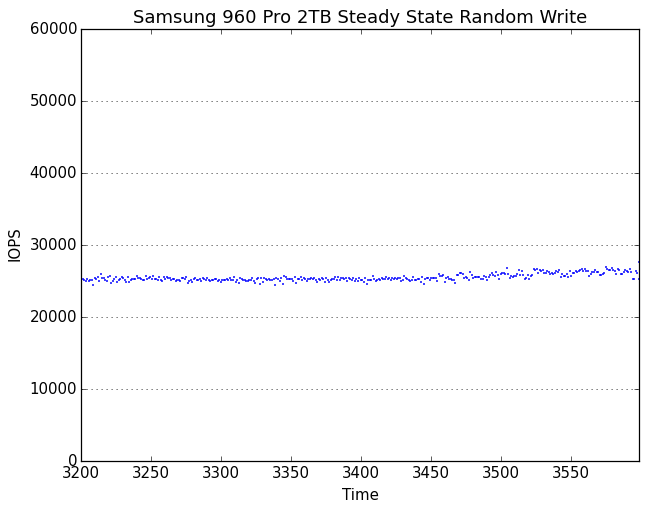The Samsung 960 Pro (2TB) SSD Review
by Billy Tallis on October 18, 2016 10:00 AM ESTPerformance Consistency
Our performance consistency test explores the extent to which a drive can reliably sustain performance during a long-duration random write test. Specifications for consumer drives typically list peak performance numbers only attainable in ideal conditions. The performance in a worst-case scenario can be drastically different as over the course of a long test drives can run out of spare area, have to start performing garbage collection, and sometimes even reach power or thermal limits.
In addition to an overall decline in performance, a long test can show patterns in how performance varies on shorter timescales. Some drives will exhibit very little variance in performance from second to second, while others will show massive drops in performance during each garbage collection cycle but otherwise maintain good performance, and others show constantly wide variance. If a drive periodically slows to hard drive levels of performance, it may feel slow to use even if its overall average performance is very high.
To maximally stress the drive's controller and force it to perform garbage collection and wear leveling, this test conducts 4kB random writes with a queue depth of 32. The drive is filled before the start of the test, and the test duration is one hour. Any spare area will be exhausted early in the test and by the end of the hour even the largest drives with the most overprovisioning will have reached a steady state. We use the last 400 seconds of the test to score the drive both on steady-state average writes per second and on its performance divided by the standard deviation.

The enterprise SSD heritage of the Intel SSD 750 continues to shine through as it holds on to the lead for steady-state random write performance, but Samsung has mostly caught up with the 960 Pro. This is a huge change from the 950 Pro, which had steady-state performance that was no better than typical SATA SSDs. A few consumer SSDs have offered great steady-state random write performance—most notably OCZ's drives based on the Indilinx Barefoot 3 controller—but the 960 Pro is the first one to reach the level of the Intel SSD 750.

In addition to mostly closing the performance gap, the 960 Pro has a great consistency score that is almost as good as the Intel SSD 750's score. While OCZ's Vector 180 offered remarkably high average performance in its steady state, it was far less consistent than the either the Samsung 960 Pro or the Intel SSD 750 and instead the standard deviation of its steady state performance was more than ten times greater.
 |
|||||||||
| Default | |||||||||
| 25% Over-Provisioning | |||||||||
After the initial period of very high performance, the 960 Pro enters a steady state with very good short-term consistency but gradual long-term variation in performance. This is more similar in character to the behavior of the Intel SSD 750 than Samsung's earlier SSDs, though it's interesting to note that the 960 Pro is more twice as fast during the initial phase before transitioning to steady state.
 |
|||||||||
| Default | |||||||||
| 25% Over-Provisioning | |||||||||
Focusing on the last 400 seconds of the test shows the 960 Pro's steady state to be essentially flawless, rounding out a full page of what can be considered to be perfect scores for a consumer drive. The performance would even make the 960 Pro a pretty good enterprise SSD, and this is usually not the case for drives with consumer-oriented firmware.










72 Comments
View All Comments
DanNeely - Tuesday, October 18, 2016 - link
Does your mobo power the m.2 slot, or just the LEDs? Baring evidence to the contrary I'd assume it's only the latter that are getting power, and enough residual power to run a few LEDs for a minute would only give a few seconds for the 960 in its deepest power saving modes, or far less while doing writes.bji - Tuesday, October 18, 2016 - link
How does your computer know to shut down in that event? Is there a signal to the operating system from the power supply to notify it that power has been lost and that it should shut down? Because if not, all that will happen is that 1 minute more of data will be written to the drive, only to be lost when the power abruptly cuts out when the capacitors lose their charge.ddriver - Tuesday, October 18, 2016 - link
Obviously it doesn't matter if the PSU doesn't send a signal to the system, which it doesn't. It wouldn't matter even if you have an UPS that could last an hour if it can't signal the system to shut down or at least flush caches before power runs out completely.noeldillabough - Tuesday, October 18, 2016 - link
I was thinking the exact same thing ACK no battery/capacitors? I'd never turn off buffer flushing.Billy Tallis - Tuesday, October 18, 2016 - link
I agree that what you've described is what those options *seem* to mean. But the semantics behind those checkboxes are clearly very different for NVMe drives and SATA drives, and it is an outright bug for Microsoft to apply the same description to both cases. The Samsung 960 Pro is also not the only drive to severely underperform without disabling write cache buffer flushing; the 950 Pro without Samsung's driver seems to be similar and I've seen this behavior on at least other vendor's NVMe controller. This is a serious concern that requires further investigation, but I'm not ready to lay the blame on the Samsung 960 Pro. If Microsoft's defaults for NVMe drives is the most reasonable behavior for consumer workloads (including the risk of power loss), then that would imply that most or all of the vendor-specific NVMe drivers are playing fast and loose with data safety, and possibly so are Microsoft's SATA/AHCI drivers.shodanshok - Tuesday, October 18, 2016 - link
"that would imply that most or all of the vendor-specific NVMe drivers are playing fast and loose with data safety, and possibly so are Microsoft's SATA/AHCI drivers"This can be quite true, especially considering as some vendors publish "turbo-cached mode" that supposedly enhance disk write speed. By the way the storage controller drives is such a critical kernel component that I will try hard to stay with Microsoft own driver, unless extensive testing on vendor-specific drivers confirms their stability.
HollyDOL - Tuesday, October 18, 2016 - link
Wouldn't INT 0 (power loss) fire fast enough to execute flush command in time for decent PSU to handle that before running out of power? Most of "decent+" PSUs seem to have quite a power buffer in capacitors to survive that long... with 300k IOPS it should manage to save with a decent margin.Even my old Corsair TX manages to survive micro-outages without computer shutting down or crashing. Afaic ATX2.01 PSU is required to endure at least 17ms power outage without losing output power. With 330k IOPS at hand it should be enough to quick save.
Not that I'd be all out to go and try :-)
beginner99 - Wednesday, October 19, 2016 - link
This would be something guys at anandtech could test. It would also probably help to build back the sites reputation and output of interesting articles.Create a script that does some file system operations, then pull the plug. Repeat 10 times for each drive, driver and settings and see what happens. Yeah a lot of work.
leexgx - Tuesday, October 25, 2016 - link
only intel SSDs that have super caps never lose data ,, Intel 320 and S3500 (some site tested it and only intel SSDs never corrupted some SSDs flat out failed the Crucial M4)http://lkcl.net/reports/ssd_analysis.html
http://www.extremetech.com/computing/173887-ssd-st...
normal SSDs that have small caps (not super caps) that say they have power loss protection that is only there to protect the page table from bee trashed not the data it self that is currently been written that still be loss
Gigaplex - Tuesday, October 18, 2016 - link
"then that would imply that most or all of the vendor-specific NVMe drivers are playing fast and loose with data safety"I would not be surprised if that's exactly what they're doing.